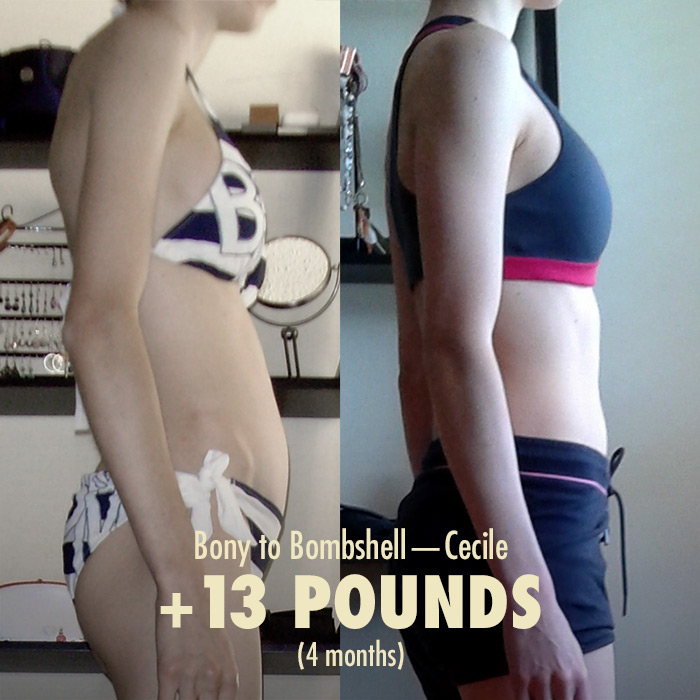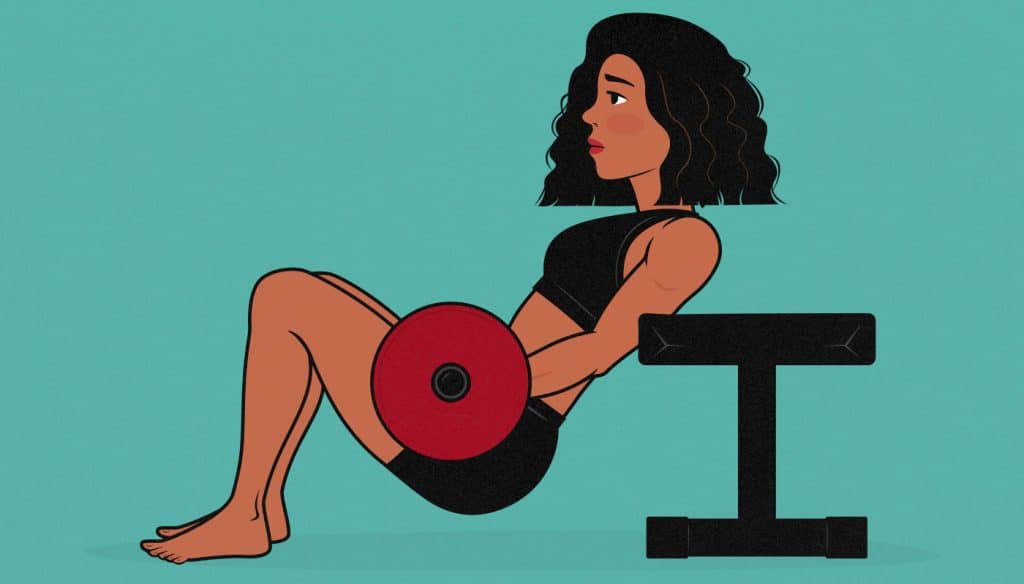
The Best Muscle-Building Workout Program for Thin Women
If you’re a thin woman who wants to build muscle, finding the right workout program can be tricky. Most women’s workout programs are designed for fat loss, not muscle growth. For example, the most common exercise routines are yoga, aerobics, and other types of cardio, all of which are great for improving your health and fitness, none of which are very good for building muscle.
If you’re trying to build muscle, gain weight, and get bigger, you might have trouble finding good workouts. That’s why we wrote this article.
- Introduction
- Getting Fitter Isn’t the Same As Building Muscle
- How to Train for Muscle Growth
- How to Structure Your Workouts
- Full Muscle-Building Workout For Women
- The Best Exercises for Building Muscle
- How to Customize Your Workout Program
- How To Work Out at the Gym or at Home
- Should You Start With Cardio Or Weight Training Workouts?
- How to Support Your Workouts With Your Diet
- The Best Muscle-Building Program for Women
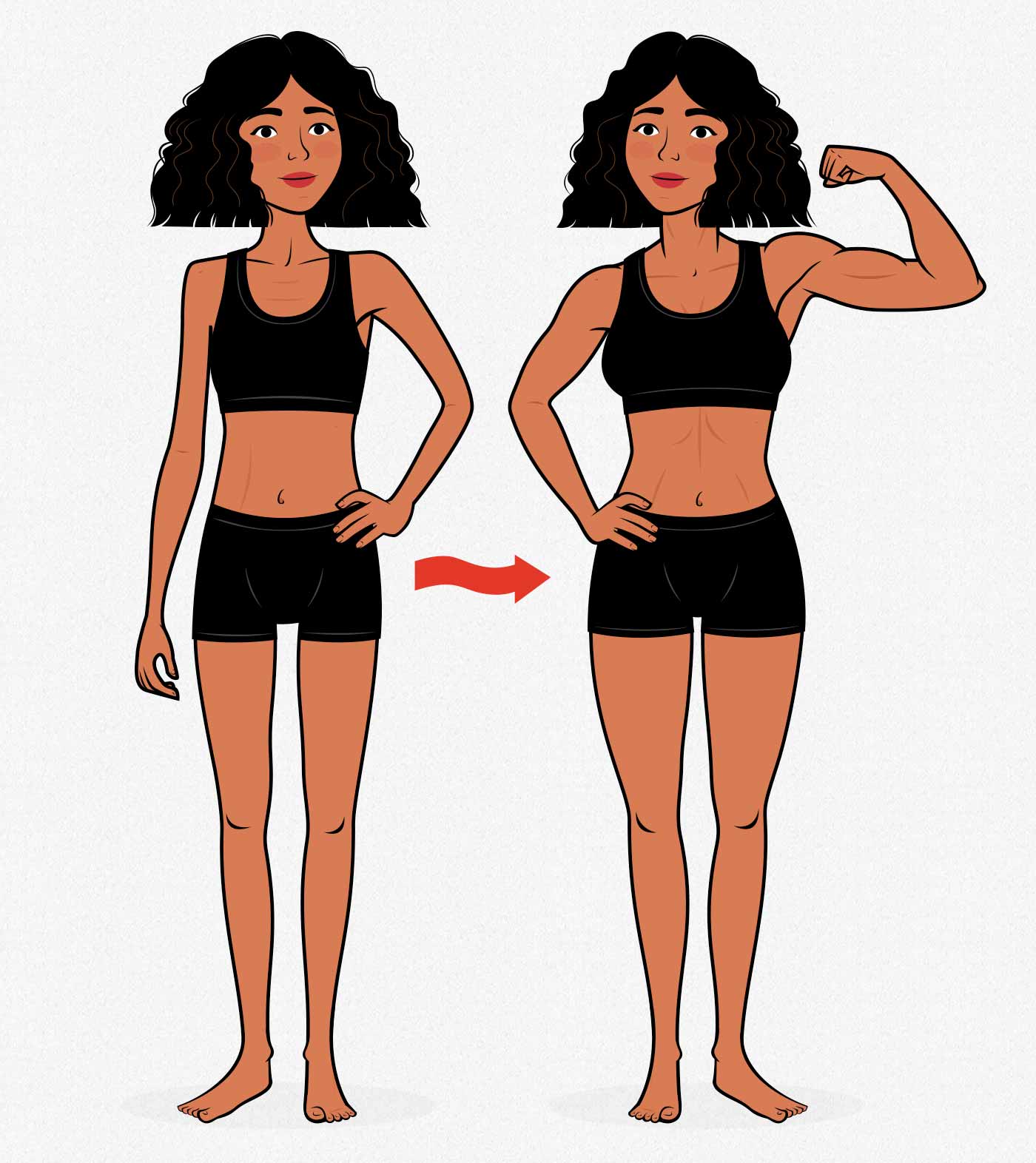
Introduction
Most women’s workout routines are for weight loss (to burn calories), fitness (such as cycling), or flexibility (such as yoga). You might start a new workout routine, try harder than everyone else, and find yourself losing weight. That can be confusing and frustrating.
When that would happen to me, I thought my genetics prevented me from gaining weight. There’s some truth to that. Some people have faster metabolisms, smaller appetites, or are naturally more active. But even if your genetics make it harder to gain weight, your frame is still eager for muscle growth. You can probably build muscle faster than almost anyone else you know.
Getting Fitter Isn’t the Same As Building Muscle
Training for Strength Versus Endurance
First of all, let’s define fitness. Fitness can mean a number of things, but in the mainstream media, it tends to mean cardiovascular fitness. This is what most workout routines are designed to improve. And that’s great. Cardio is fantastic for improving general health.
The problem is, cardio isn’t very good for building muscle. For most women, that isn’t a problem. Most overweight women are already quite strong, especially in their lower bodies. But if you’re naturally thin, it can be confusing.
You may have seen these examples already, but here’s a woman with a naturally thin bone structure who’s developed world-class cardiovascular fitness:
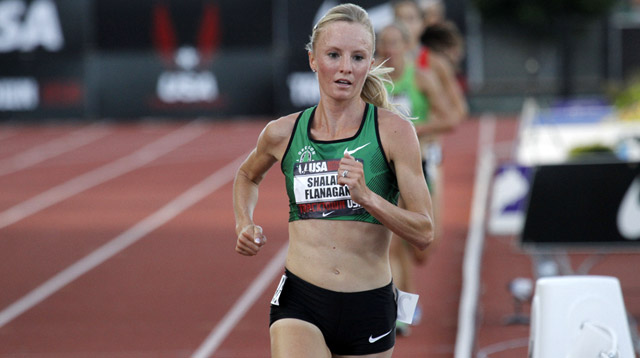
Below is another woman who also appears to have a naturally thin bone structure. Except in her case, she’s been lifting weights to develop her strength and power:
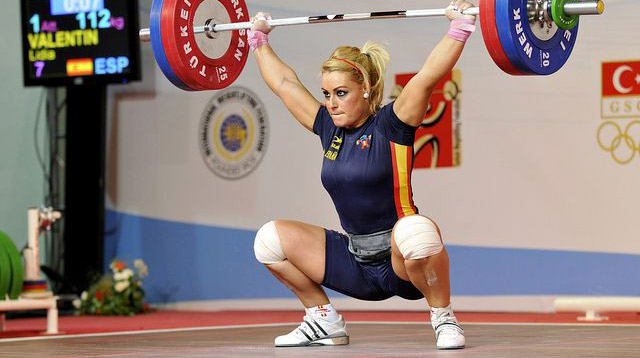
Both bodies are fantastic. They’re both Olympians, after all. They’re the best in the world at what they do. However, if your goal is to build muscle, you can see that you need to train for it.
I know these are just examples, but they’re representative examples of what’s seen in research. It doesn’t matter how gruelling your workouts are or how fearsomely your muscles burn with a hellish fire. If the stimulus isn’t heavy enough, it won’t cause you to adapt by becoming bigger and stronger.
Most Women Are Already Strong
There are a lot of reasons why overweight women are already so muscular. To make a long story short, though, gaining weight causes both fat gain and muscle growth. Even with a completely sedentary lifestyle, gaining ten pounds will usually result in a good 3-4 pounds of muscle and 6-7 pounds of fat.
Moreover, carrying around that extra body weight will make them even more muscular. Going up a flight of stairs while weighing 200 pounds requires lower-body strength. If you weigh 100 pounds, imagine going up a flight of stairs while carrying 100 pounds. Imagine how good that would be for building muscle in your thighs and hips. That’s what overweight women are doing every single day of their lives, often several times per day.
Overweight women are already strong. For them, getting toned actually does mean getting smaller. They tone by removing the fat on top of their muscles. That reveals that large muscles hidden underneath.
Thin Women Need to Train to Build Muscle
For naturally skinny women, though, getting curvy, strong, and fit means developing more lean muscle mass. On the plus side, we don’t need to worry about losing fat.
Furthermore, cardio isn’t all we need for general health. The World Health Organization (WHO) recommends doing at least 150 minutes of cardio and doing at least two strength training workouts every week. So if you’re a naturally skinny woman who’s trying to get bigger, stronger, and curvier, you should technically be doing cardio and strength training.
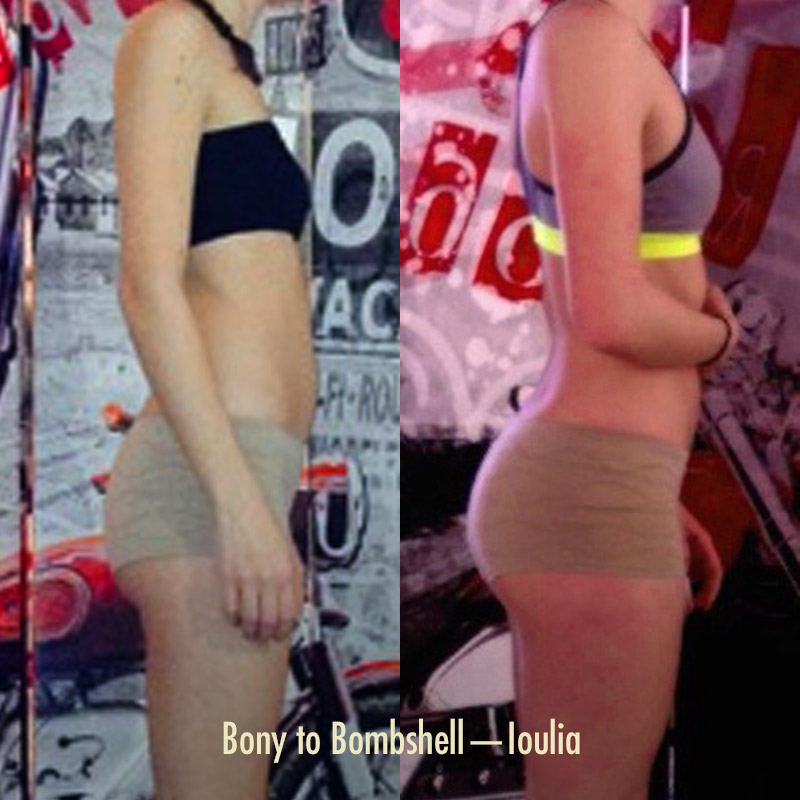
This advice is confusing for another reason, though. WHO recommends that women do “strength training,” but strength training has a couple of different definitions. Let’s talk about what they mean.
How to Train for Muscle Growth
Is Strength Training Good for Building Muscle?
In the fitness industry, strength training normally means focusing on the barbell squat, deadlift, and bench press. Strength training is about trying to get stronger in a powerlifting sense. That’s not what the World Health Organization means. They’re talking about training to build muscle and become stronger.
This is an important distinction because that type of strength training isn’t the best way to build muscle. Even if your goal is getting stronger, there are better ways to gain general strength.
The best way to gain new muscle mass is to do “hypertrophy training.” Most styles of resistance training will stimulate some muscle growth, but hypertrophy training is the easiest and most effective way to do it, and it has great carry-over into general health and fitness. If you’re a skinny-fat girl, it makes for the best default.
What Is Hypertrophy Training?
Hypertrophy training (often called bodybuilding) is the type of exercise designed to build muscle. Hypertrophy training also comes with a host of other benefits: greater strength, improved fitness, better general health, greater bone density, increased longevity, and even improved cardiovascular health. However, since hypertrophy programs are designed with muscle growth in mind, these other benefits are just byproducts.
With hypertrophy training, you’ll gain a maximum amount of muscle. It’s better for improving your cardiorespiratory fitness than strength training, but that’s not what it’s for. You’re supposed to combine it with a good cardio routine.
Most of these “bodybuilding” programs aren’t designed for women. As soon as you start googling about building muscle, you’ll find bulking programs. But you probably aren’t trying to get “bulky,” so why would you be looking for a “bulking” program?
By that same token, most women’s bodybuilding information isn’t written for everyday women. If you aren’t trying to look like a female bodybuilder, there can be a disconnect there.
To be fair, a lot of the information on these sites is probably perfect for you. If you want to build a bigger butt while gaining overall strength, a bodybuilder’s approach to squatting and deadlifting is good for that.
Curviness is found on the path to bulkiness. If you gain 10 pounds of muscle, you may wind up looking curvier but still slender:
Depending on how skinny you’re starting off, you might be able to gain even more weight while still looking quite slender:
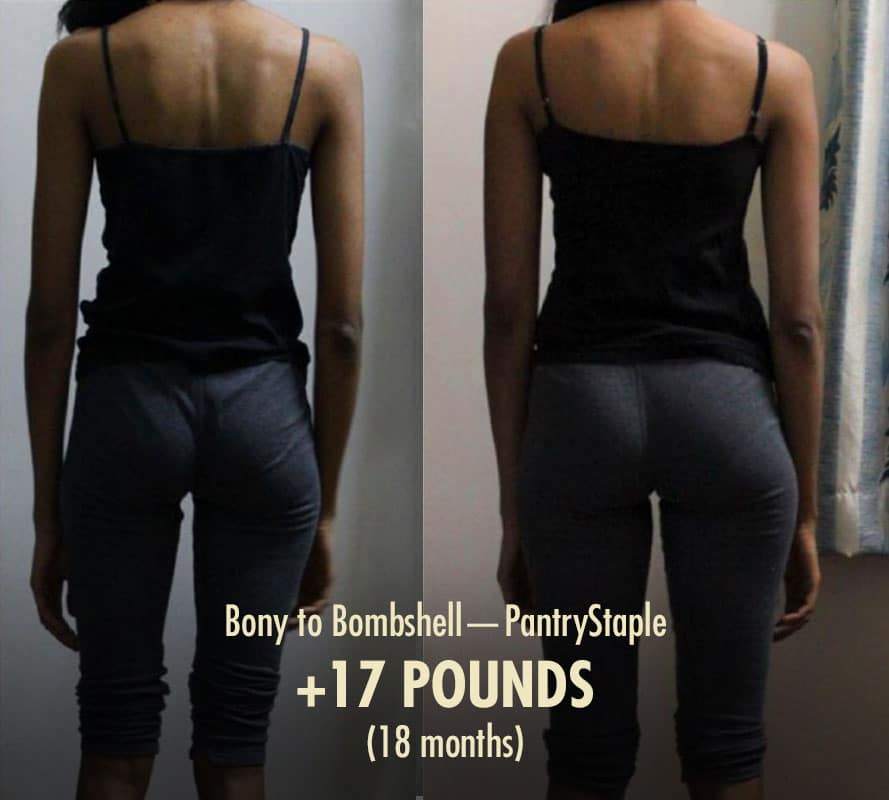
Regardless, at a certain point, you’ll build enough muscle that you start to look remarkably strong and curvy. Here’s a good example of that:

Now, what if you kept going? What if you gained 30, 40, or 50 pounds? That’s when you might start looking bulky. I’ve personally gained 70 pounds. Marco has gained 63. That has bulked up our physiques quite a bit. Mind you, we’re men, and we’re tall. But keep in mind that it takes quite a lot of muscle to go from skinny to bulky. You can step gracefully off the gain train long before you get there.
Furthermore, your muscles will eventually reach their genetic limit. There’s only so big that your arms can get. And if you have naturally thin bones and you’re naturally thin, you’re going to keep that bone structure even as you bulk up. That means that even at your genetic potential, you’ll still look like a naturally thin woman. You’ll look stronger and more athletic. Not bulkier.
(Here’s our article about muscle growth and strength potential for naturally skinny women.)
The Principle of Progressive Overload
Hypertrophy training boils down to challenging your strength, eating enough food and protein to recover and grow, and then challenging your strength again. And since your muscles have grown back bigger, over time, you become more capable. So you try to lift more weight or eke out more repetitions. This is called progressive overload.
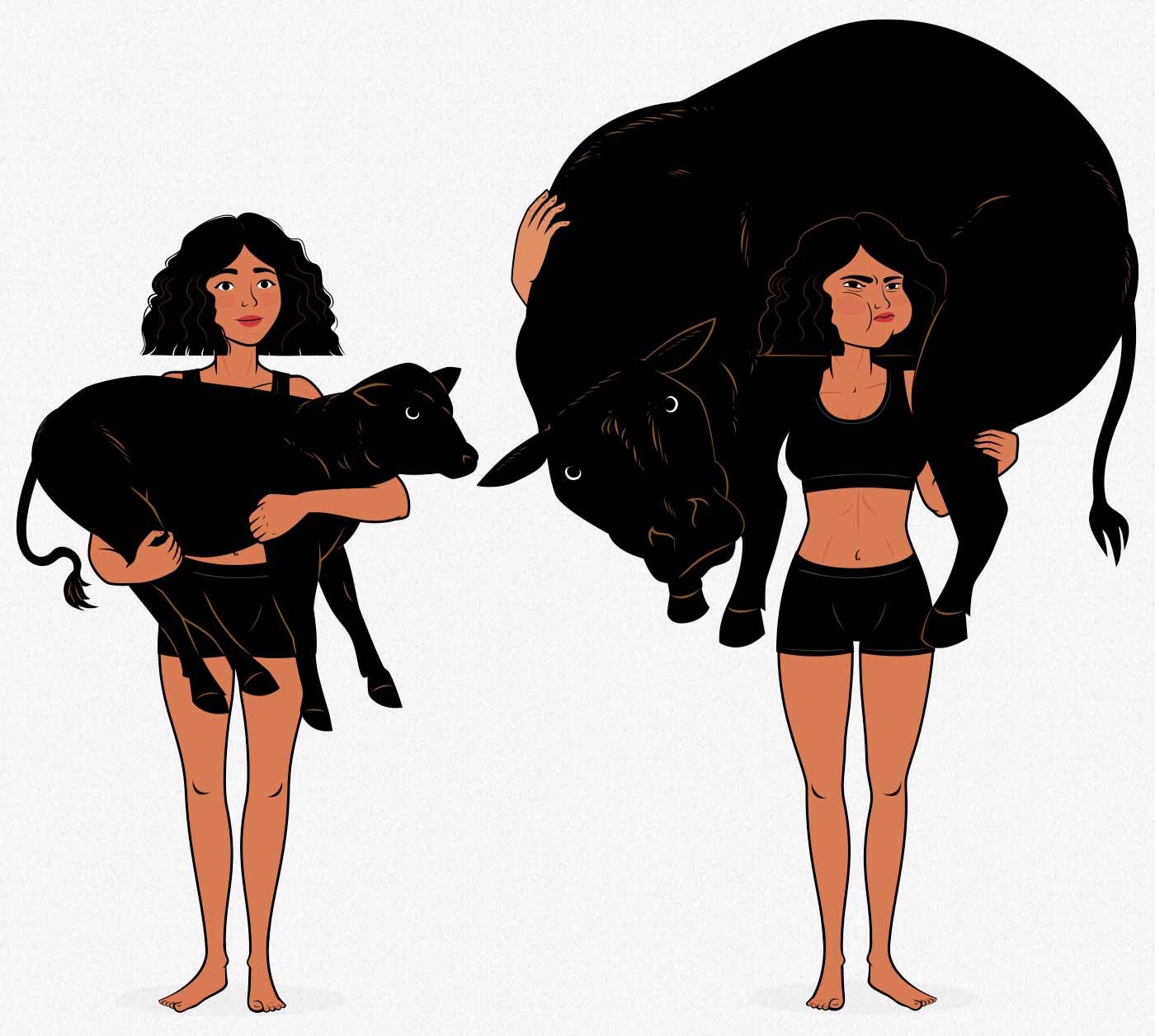
Think of the old myth of Mila of Croton. Mila was determined to be the strongest wrestler in Greece, so she started carrying a calf up a hill every morning. Over time, her muscles grew bigger, making her stronger. But the calf was also growing heavier, continuing to challenge her.
By the time the calf grew into a bull, Mila wasn’t skinny-fat anymore. She had become a strength legend, not just in Greece, but also on Instagram.
How to Structure Your Workouts
You can build muscle with both light and heavy weights. But to make it as easy as possible, choose an amount of weight you can lift for 6–20 repetitions. That’s light enough that you can get at least a few reps in, allowing you to do some solid work. And it’s heavy enough to develop muscular strength instead of endurance. If you do 2–4 sets per exercise per workout, that’s usually enough to stimulate a maximal amount of muscle growth.
A challenging workout can stimulate up to 2–3 days of muscle growth. To keep your muscles growing all week long, you’d train them every 2–3 days. That means you can train with all kinds of different workout schedules:
- 2-day workout routines
- 3-day workout routines
- 4-day workout splits
- 5-day workout splits
- 6-day workout splits
We recommend starting with 3 full-body workouts each week. That will give you a good balance of stimulation (stress) and recovery (growth). 2-day routines are better for slower progress, maintenance, and general health. Training 4+ days per week is better for advanced lifters who are already near their genetic potential.
Finally, you have to train hard enough. If you’re focused on progressive overload, lifting more weight or doing more reps each workout, you’ll eventually get to the point where you’re pushing yourself extremely hard, fighting tooth and nail for progress. But if you want great results right out of the gate, make sure you’re taking your sets close to muscular failure.
If you aren’t sure how close to failure you’re lifting, try taking the set all the way to failure—to the point where your muscles don’t have the physical strength to keep going. Once you know what failure is, you’ll be better at stopping just shy of that point. If you fail at 6 push-ups, stop at 4–5. And then next workout, hopefully, you’ve grown stronger. Try to get an extra rep.
Full Muscle-Building Workout For Women
Here’s a simple example:
- Goblet squats: 3 sets of 12 repetitions.
- Raised push-ups: 3 sets of as many reps as possible (AMRAP)
- Romanian Deadlifts: 3 sets of 12 repetitions.
- One-Arm Dumbbell Rows: 3 sets of 12 repetitions.
- Bodyweight hip thrusts: 3 sets of as many reps as you can do. If you can do more than 20 reps, try doing single-leg hip thrusts.
GET THE GOOGLE SPREADSHEET OF THE
FREE BEGINNER’S FULL-BODY WORKOUT For Women
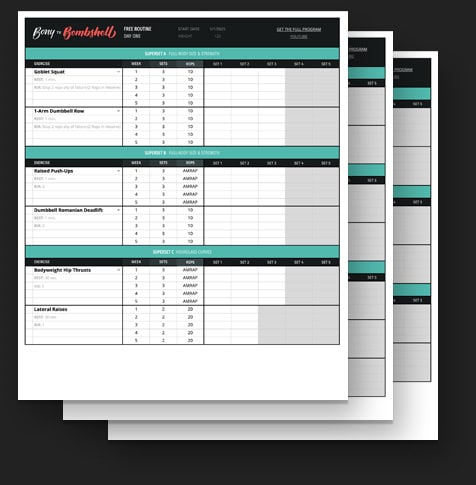
Get the workout as a Google spreadsheet. You’ll be able to pick from exercise alternatives, fill out the sheet, and get our beginner’s warm-up.
Plus, we’ll make sure you’re on the Bony to Bombshell newsletter, and send you all of our best women's muscle-building content.
The Best Exercises for Building Muscle
Goblet Squats for Bigger Legs
Push-Ups for A Bigger Chest
Romanian Deadlifts for Bigger Hips
Dumbbell Rows for A Stronger Back
Hip Thrusts for Bigger Glutes
For more, we have a full article on the best muscle-building exercises.
How to Customize Your Workout Program
Your Workouts Should Match Your Goals
Let’s say you’re a naturally thin woman who wants better muscle definition, more of an hourglass figure, bigger hips, better posture, and more overall strength.
- Start with a foundation of strength. Start with the big compound lifts. Squats, deadlifts, push-ups, chin-ups, and rows are great for that.
- Add isolation lifts that suit your goals. If you want bigger hips, think of Romanian deadlifts and hip thrusts. If you want toned arms, think of biceps curls and triceps extensions. If you want bigger thighs, think of split squats and step-ups.
- You don’t need to do isolation lifts for muscles you don’t want to grow. If your waist is already big enough, you don’t need crunches. The compound lifts will give you a strong core either way. If you don’t want bigger arms, you don’t need to do biceps curls. Chin-ups and rows will give you strong arms either way.
Here’s what a few months of working out can do. Aomi did a full-body workout program 3x per week. She focused on compound exercises but added in isolation exercises that matched her goals.
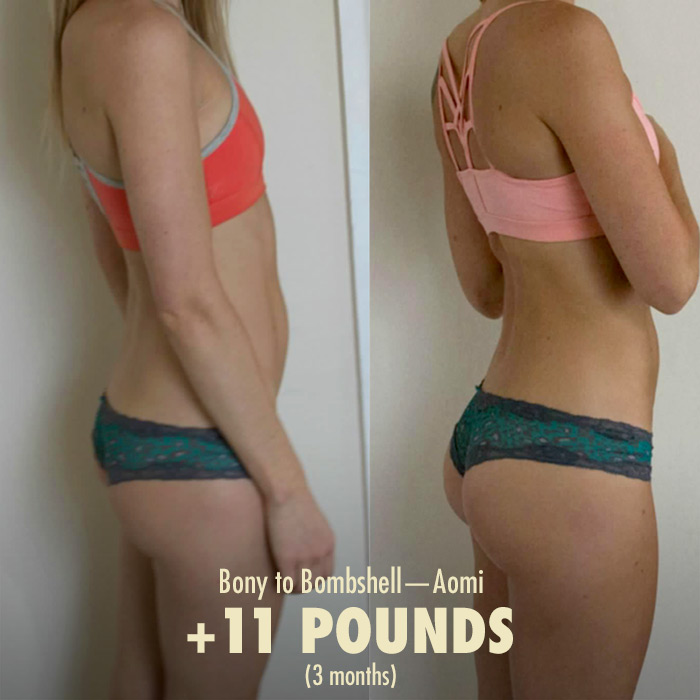
Obviously, every woman has different goals. This is just one example. The point is that you can customize your workouts to build muscle where you want it most.
That’s how we designed the Bony to Bombshell Program. We give you a full workout program, but the exercises are customizable, and we can tailor the program to your goals in the community.
Do Exercises That Match Your Experience Level
If you’re new to lifting and you start attempting back squats and barbell deadlifts, things get real awkward real quick. To get around the steep learning curve, do lifts that match your experience level. We recommend goblet squats instead of back squats and dumbbell sumo deadlifts instead of conventional barbell deadlifts.
These variants are easier to learn, you won’t feel as awkward doing them, they build just as much muscle, they’re safer, and you won’t need to commandeer a squat rack.
Also, remember that some bodyweight exercises are great for building muscle. Think of exercises like push-ups, chin-ups, crunches, and planks. For example, push-ups are just as good as bench presses for building your chest, shoulders, and triceps, and they’re better for improving posture.
Again, though, start with beginner variations. You can ease into push-ups by starting on your knees or by raising your hands up on a bench. You can ease into chin-ups by using a stool to start in the top position, then lowering yourself slowly down.
If you to delve deeper into the art of training for muscle growth, check out our full beginner workout for women.
How To Work Out at the Gym or at Home
How to Work Out at the Gym
Pretty much every naturally skinny woman we’ve ever met has found the gym intimidating. We’re no exceptions to that. I was absolutely terrified of going to the gym for the first time.
It’s not that skinny women are cowards. It’s just that the gym seems like a place where people are judged based on the size of their muscles… and we have naturally smaller muscles. If you aren’t confident about the size of your muscles, this makes the gym a very intimidating place. And then there are the big musclebound bros.
If you do have the courage to get yourself to the gym, you’ll soon learn that the gym isn’t all that intimidating. Even the bros are often kind and welcoming. And the ones who aren’t are usually too busy admiring their biceps or flexing their glutes in the mirror to even notice you.
I didn’t know that, though. So my solution was to build muscle at home. That’s how I gained my first 20 pounds. Interestingly, long before we met, Cassandra had done the same thing, bulking up with bodyweight workouts at home. That’s what gave us the confidence to step foot into the gym.
How to Work Out at Home
This is by far the simplest way to build at home. All you need are some heavy adjustable dumbbells that go up to 60–100 pounds and a lifting bench. That’s all you need to do our Bony to Bombshell Program. In fact, you don’t even really need the bench. We have plenty of members who do the program with just two adjustable dumbbells.
When buying adjustable dumbbells, the fancy option is getting some IronMaster ones. However, you can get simple ones like the ones pictured below. Are they perfect? No. Will they help you gain 20+ pounds of muscle? Absolutely.

I used a setup like this for several years while living in a small condo in downtown Toronto. I didn’t have much space, so I’d carry the dumbbells and bench into the living room, do my workout, and then store them in the closet.
You don’t even need the dumbbells. You could probably get away with just 3 kettlebells—light, medium, and heavy. That will be enough to gain your first 10 pounds of muscle, after which you can keep building your home gym.
How to Build A Barbell Home Gym
Nowadays, now that I live in a bigger house with a spare room, I’ve built myself a simple barbell home gym. If you have a spare room or garage, and you have $500–1500 available, this is a great way to build a home gym that you can use for a lifetime.
Here’s how to build a simple barbell home gym.
In the long run, this is cheaper than getting a gym membership. But it can certainly be a large upfront cost, especially if you don’t know yet if you’ll adopt weight training as a long-term habit. Here’s the home gym I built that my wife and I train in.
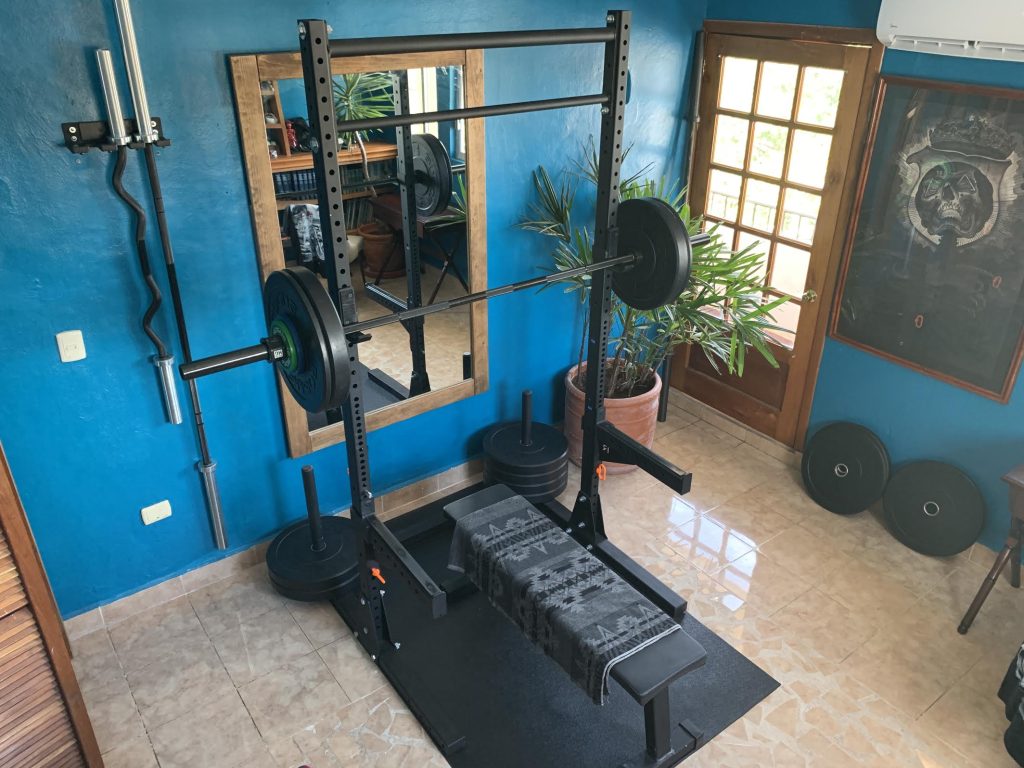
Should You Start With Cardio Or Weight Training Workouts?
In an ideal world, you’d eventually have a lifestyle that involves both cardio and hypertrophy training. However, if you’re currently fairly sedentary, it might make more sense to ease into this a little bit more slowly.
If you had to pick just one type of exercise to help you get bigger, fitter, and stronger, you should choose hypertrophy training. That isn’t true for everyone, but if you’re naturally thin, it’s probably true for you. It was for us.
The good news is that lifting weights will also raise your heart rate, allowing you to make cardiovascular improvements as well. If you do three weight training workouts per week, each lasting about an hour, that will count for about 90 minutes of cardiovascular exercise. That’s more than enough for a beginner to improve their cardiovascular fitness. Pair that with a short daily walk, and you’re off to a killer start.
How to Support Your Workouts With Your Diet
The Importance of a Calorie Surplus
After you’ve challenged your muscles with a good workout, they’ll want to adapt by growing bigger and stronger. You need to fuel that adaptation with energy. If you’re overweight, you can get that energy from your stored body fat. If you’re lean or thin, you’ll need to get that energy from the food you eat. Your body can then invest that extra energy into building muscle.
There are two ways to eat more food:
- You could add a little food to your diet. It doesn’t take much. 250 calories are often enough to get the scale moving, at least at first. That’s a large handful of trail mix, a smoothie, or apple slices dipped in peanut butter. If it isn’t enough, or if you stop gaining weight, add a little more. Keep weighing yourself and adjusting as needed.
- Count your calories. Another approach is to count your calories with a calorie-tracking app. It used to be a real pain, but modern apps make it quite convenient. If you want to give it a try, we’re affiliated with MacroFactor. We’ve found it to be the best calorie-tracking app for building muscle. You can get an extended free trial with the code “b2b”.
Whatever approach you choose, weigh yourself every week, and add more food whenever you need to. Every pound of muscle you build will burn around 12 more calories per day. So after you gain 10 pounds, expect to need around 120 more calories. Plus, your metabolism may adapt as you get used to eating more foods.
Your appetite will change with you. Don’t worry about needing to eat more food. That was a big fear of mine, but maintaining muscle wound up being much easier than I expected.
The Importance of Protein
In one study, half the participants ate 0.5 grams of protein per pound bodyweight per day. The other half ate a whole gram of protein per pound bodyweight. Twice as much. For a 130-pound woman, that’s 65 grams versus 130 grams of protein each day.
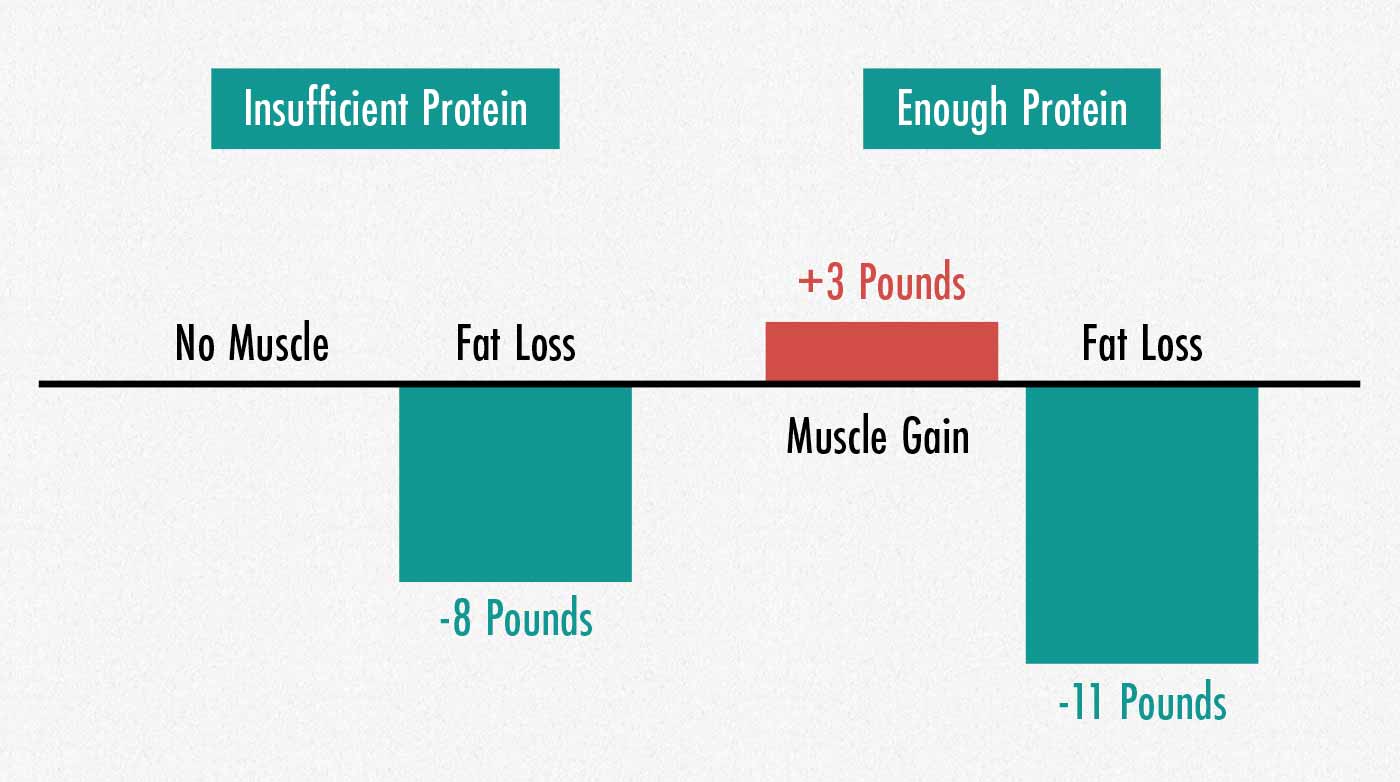
After four weeks, the group eating an average amount of protein lost 7.7 pounds of fat but failed to gain any muscle. That’s great! Their workout routine was enough to preserve all of their muscle mass.
If we look at the other group, though, the results are incredible! Not only did they lose 11 pounds of fat, but they were also able to gain 3 pounds of muscle.
When you’re gaining weight, you would build muscle either way. A calorie surplus is a powerful muscle-building tool. But eating more protein would yield more muscle growth and less fat gain. You may even lose fat while building muscle. Maybe.
How Much Protein Should You Eat?
Now, the next thing to keep in mind is that you can only build muscle so fast. Once you’re eating enough protein to fuel that muscle growth (and keep your hair and nails healthy), then eating extra protein won’t do anything more. That cut-off point is usually around 0.7 grams of protein per pound body weight per day.
For example, a skinny woman who weighs 120 pounds would need to eat at least 84 grams of protein per day to maximize her rate of muscle growth. There’s nothing wrong with eating even more protein, but it wouldn’t further improve her results.
The Best Muscle-Building Program for Women
The best way to build muscle as a naturally skinny woman is to lift weights, following a well-designed hypertrophy training program full of exercises that challenge the muscles you’re most eager to grow. Usually, but not always, that means following a program designed for women.
But the best program for you depends on your goals. We’ve had some female clients who want to bulk up their shoulders and arms. That’s no less valuable, just less common. That’s where customizable programs and in-person coaching can help.
Then you’ll want to combine that type of lifting with an abundant and nutritious bulking diet. One with plenty of whole foods, protein, and enough calories to sustain muscle growth.
The newer you are to lifting, the more exciting this news is. You may think your genetics are keeping you skinny, but that couldn’t be further from the truth. You may not be hungry, but your bone structure is. It’s eager to explode into muscle growth. You can build muscle at an incredibly rapid pace. This is due to newbie gains. You can see examples of naturally thin women building muscle here.
If you want us to walk you through the entire process of bulking muscle, check out our Bony to Bombshell Program. It includes a full training program, tutorial videos teaching every exercise, a full diet guide, a complete recipe book, and coaching from us in our online member community. We’ll be with you every step of the way. Results guaranteed. Unconditional refund policy.
GET THE GOOGLE SPREADSHEET OF THE
FREE BEGINNER’S FULL-BODY WORKOUT For Women

Get the workout as a Google spreadsheet. You’ll be able to pick from exercise alternatives, fill out the sheet, and get our beginner’s warm-up.
Plus, we’ll make sure you’re on the Bony to Bombshell newsletter, and send you all of our best women's muscle-building content.

